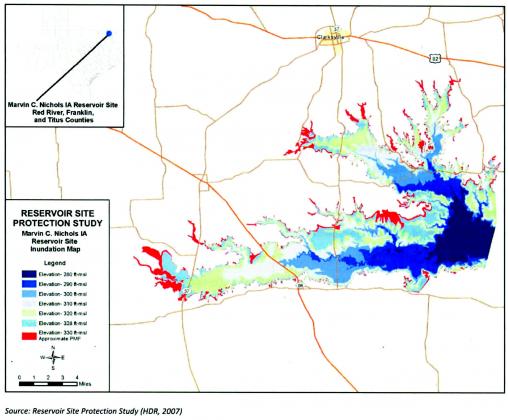Editor’s Note: This is the first in a series of articles exploring the impact of Marvin Nichols Reservoir.
It came as little surprise to most that the Texas Water Development Board voted to keep Marvin Nichols Reservoir in the State Water Plan back in 2014, and it is no surprise at all that the proposed lake is still the desire of the folks in Region C (Dallas area) and the North Texas water planners.
It is also no surprise that most agree the huge hole in the ground they want to fill up with water to sate their undying thirst is something that Northeast Texans do not need.
On top of that, the mitigation that will be required if Marvin Nichols ever comes to be has the potential to gobble up the entire Sulphur River basin, virtually eliminating its use for anything other than a wildlife sanctuary, like the White Oak Creek Wildlife Management area.
So, exactly why is this lake, that Northeast Texas does not need to fulfill its water need for the next 100 years, still in the state water plan? Why is this lake that is hated by locals, opposed by most in our area, and one that will undoubtedly do drastic harm to timberlands still in the news?
Neighbors in the D-FW area say they need it badly to meet their future needs. They say they need it, they post needs assessments that show their ever-burgeoning populations will be thirsty if they don’t get it, and they have the political clout and dollars to make it happen.
They will likely make it happen despite protests and the obvious and documented negative impacts that it could bring.
An assessment of the reservoir formulated years ago by the engineering firm of Freese and Nichols stated, “The primary impact of the proposed Marvin Nichols Reservoir on wildlife habitat would be the inundation of habitat by the reservoir.” However, their assessment was labeled by water planners in our area as “fatally flawed” because it failed to detail the true depth of those impacts on the area.
Those impacts include precious timberlands, wildlife habitats, historic sites and homesteads that have belonged to their families for generations. The assessment by Freese and Nichols also widely ignored the impact to the people who live in Northeast Texas that would suffer from loss of homes, farmlands, history and, most notably, jobs and income. The loss of mineral and oil rights alone would be staggering, and the loss of the timber would be nothing less than devastating.
Around 2000, when Marvin Nichols became a hot topic, and people like Shirley Shumake, Max Shumake, Jim Presley and many others first began the battle against the proposed lake, I was given a personal tour of the Shumake homelands. These were and are still pristine pastures, lakes, trees and homesites that have been guarded and a part of their family for generations. Out there among the huge oaks running alongside the Sulphur River, I saw Indian burial mounds and the ground was literally covered in artifacts. Clay pots, arrowheads and other signs of life from a time long ago lay there as a reminder of a civilization lost.
I saw a bridge, now buried in the mud and sand and water of the Sulphur, that was once used as a major crossing for the river by travelers of all kinds.
I heard as people like the Shumakes and Seaby and Olen Love described the love for their family lands that had been a part of their history for more than 150 years. These are lands that are home to cattle, crops and woodlands, and lands that they have hunted, fished, cultivated and protected since the day they were born.
Do we really want to allow another piece of history to be buried under water for the sake of the water hungry folks in Dallas? Do we really want to give up water, water rights and the history of a people just so D-FW can keep growing?
It was once said that Marvin Nichols Reservoir would never be approved. There would never be a shovel full of dirt moved. There was simply no need to worry and all the hype was just that, hype.
I suggest that you go tell that to the folks over between Bonham and Honey Grove, as they sit and watch right now today the dirt being moved to create the dam for the Lower Bois D’Arc Creek Reservoir.
What it all boils down to was best said by Janice Bezanson, director of the Texas Conservation Alliance, in 2014: “No one is trying to keep folks in the Metroplex from having the water they need. There are ways to do that without devastating the economy of a 15-county region of the state.”


